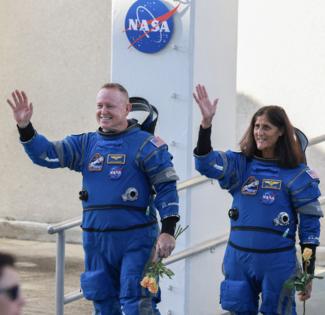Boeing Starliner crew 'not stranded,' but 'not in any hurry' to get home from ISS
Published in Science & Technology News
NASA officials gave an update Friday on the status of Boeing’s Starliner docked at the International Space Station, and when its two astronauts would get the OK to come home.
“I want to make it very clear that Butch and Suni are not stranded in space,” said NASA Commercial Crew Program Manager Steve Stich on a media call. “I want to make it real clear that we’re not in a rush to come home.”
Barry “Butch” Wilmore and Sunita “Suni” Williams arrived to the space station back on June 6 a day after launching atop a United Launch Alliance Atlas V rocket from Cape Canaveral Space Force Station for what was supposed to be about a week on board the International Space Station on the Crew Flight Test mission for the spacecraft as it makes its first ever human spaceflight.
Issues with both helium leaks and thrusters on the spacecraft’s attached propulsion module, though, showed up on the trip up to the ISS, and has continued to push any planned target return date as NASA and Boeing pore over data and potential dangers before the flight home.
Stich reiterated, though, that the spacecraft is considered safe, and even OK for its two astronauts to ride home in in case of an emergency. In fact, a Russian-operated satellite breakup at a lower altitude than the ISS on Wednesday forced all nine of the crew on board to temporarily go into their respective spacecraft acting as “lifeboats” as a precaution, climbing into the Soyuz, SpaceX Crew Dragon and Starliner in case the debris field from the satellite became a threat.
“There’s no new issues to report today. We don’t have any new problems,” Stich said. “The vehicle at station is in good shape.”
That said, since the propulsion module will separate from the spacecraft and burn up on reentry, teams want to work through the issues as much as possible before they lose the hardware on the trip home. In tandem, teams at the White Sands Test Facility in New Mexico will go through a rigorous test regimen of a test thruster to replicate the flight up and test what’s expected on the flight back.
“We’ll recreate that profile, then we’ll put a pretty aggressive profile in the thruster for the downhill phase,” Stich said. “Then we’ll give engineers a chance to go look at that thruster and take a look at it and make sure that there’s nothing that’s unusual about the thruster.”
That means no return date is in target yet, but Stich noted that before launch the spacecraft had a 45-day upper limit planned because of crew module battery life. Teams, though, are working to get that limit expanded up to 90 days, and that Starliner is designed to be docked to the ISS for half a year if and when it gets approved for regular missions.
“We’re not going to target a specific date until we get that testing completed, we look at the fault tree and then we understand the path for it,” Stich said. “Then (we will) have an agency-level review and then we’ll lay out the rest of the plan from undock to landing. I think we’re on a good path.”
...continued
©2024 Orlando Sentinel. Visit at orlandosentinel.com. Distributed by Tribune Content Agency, LLC.







Comments